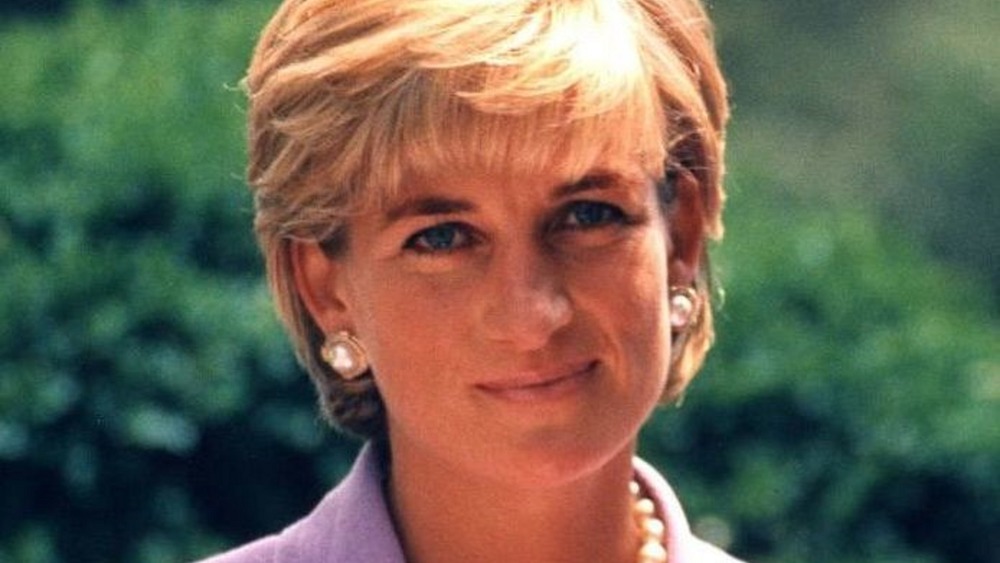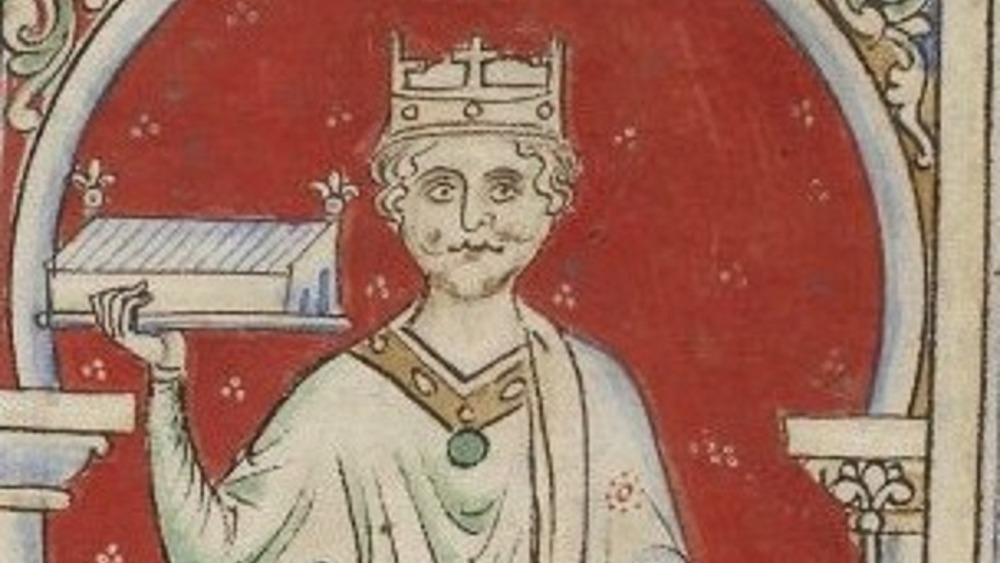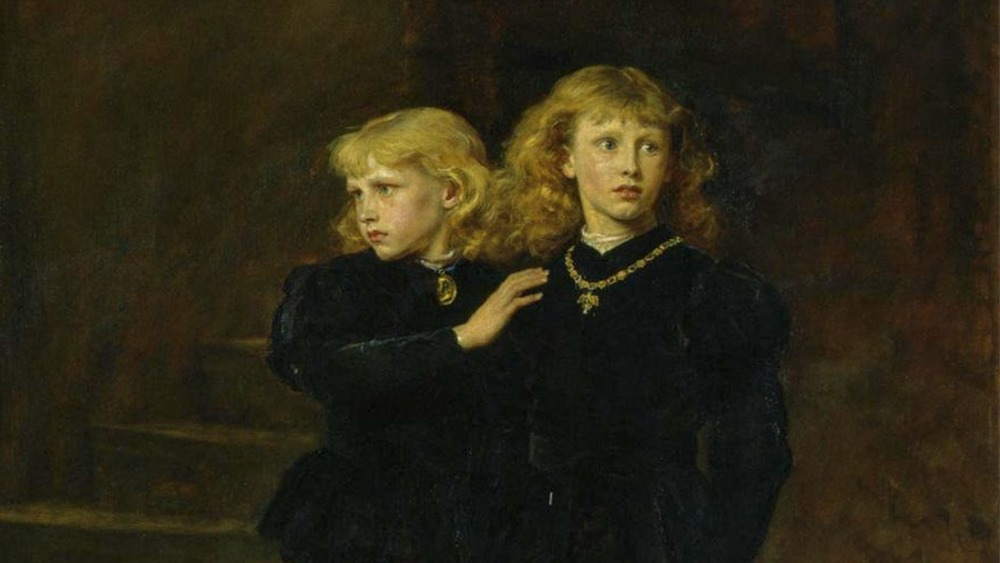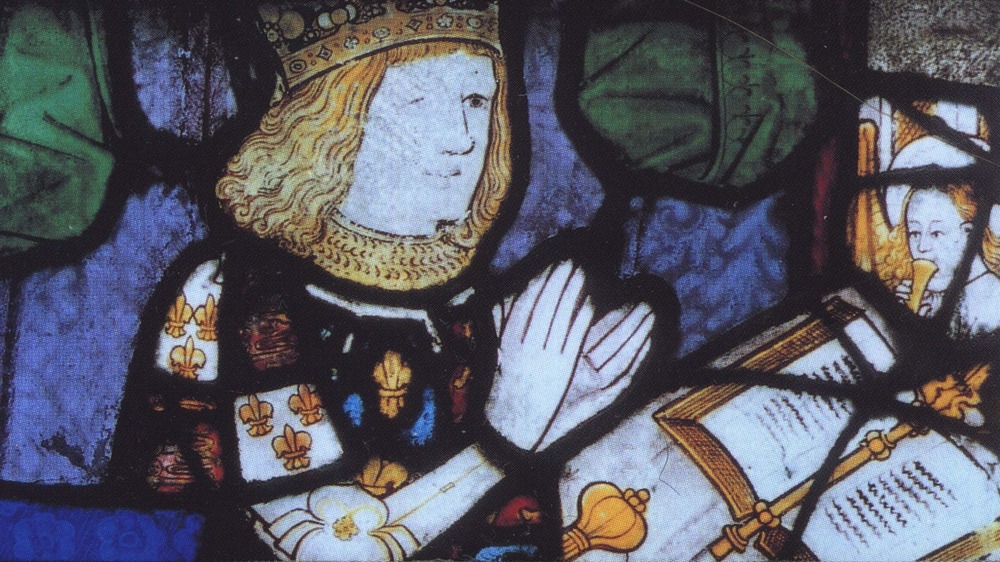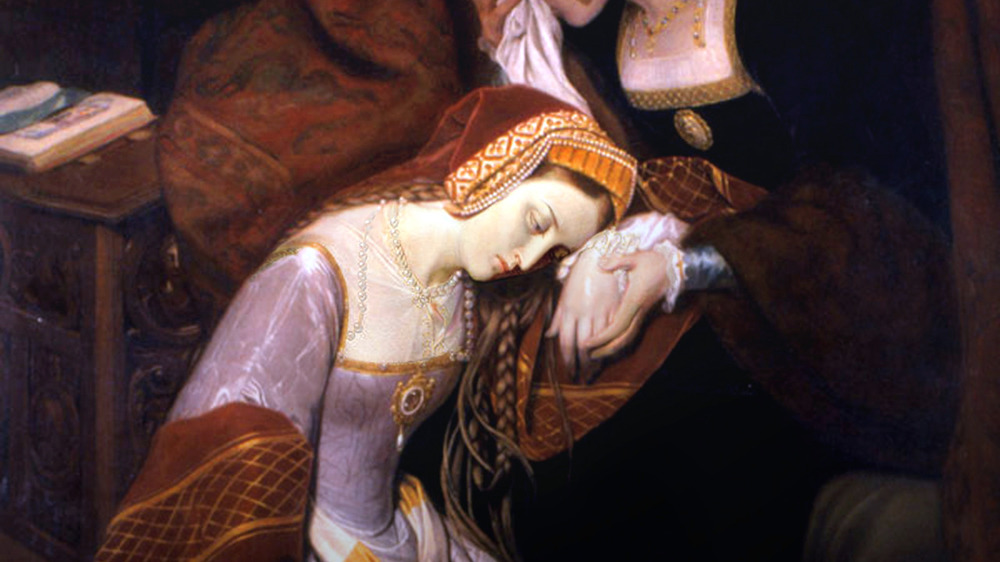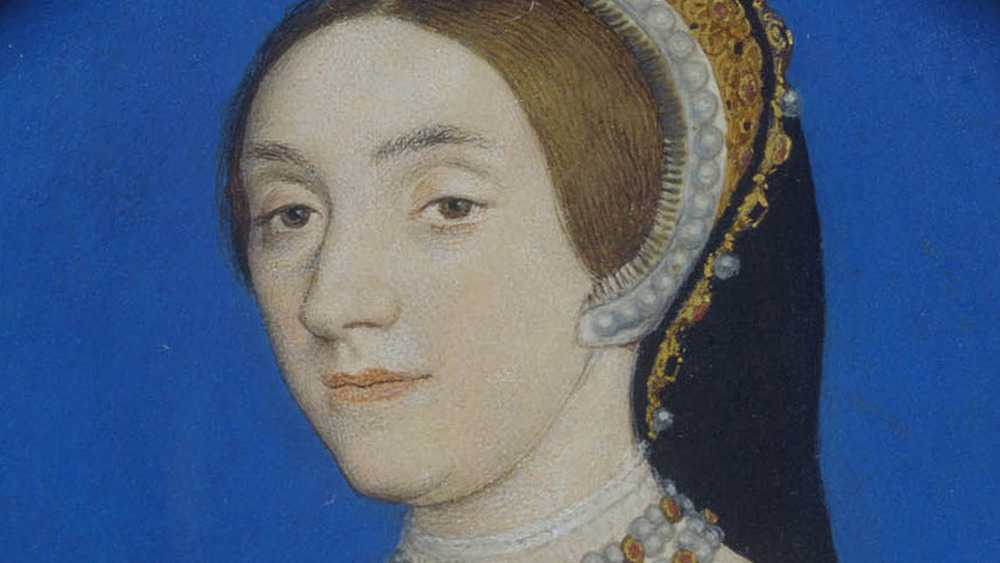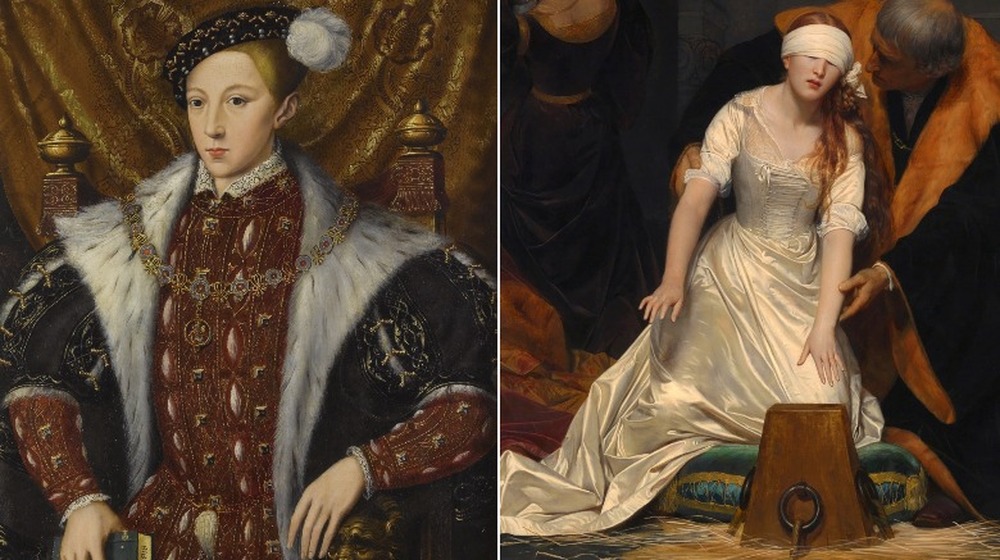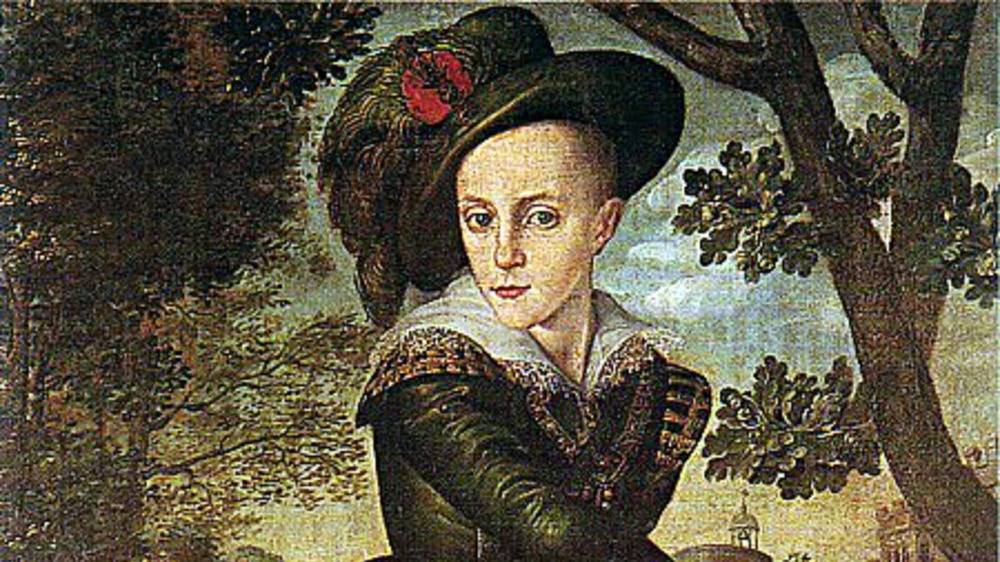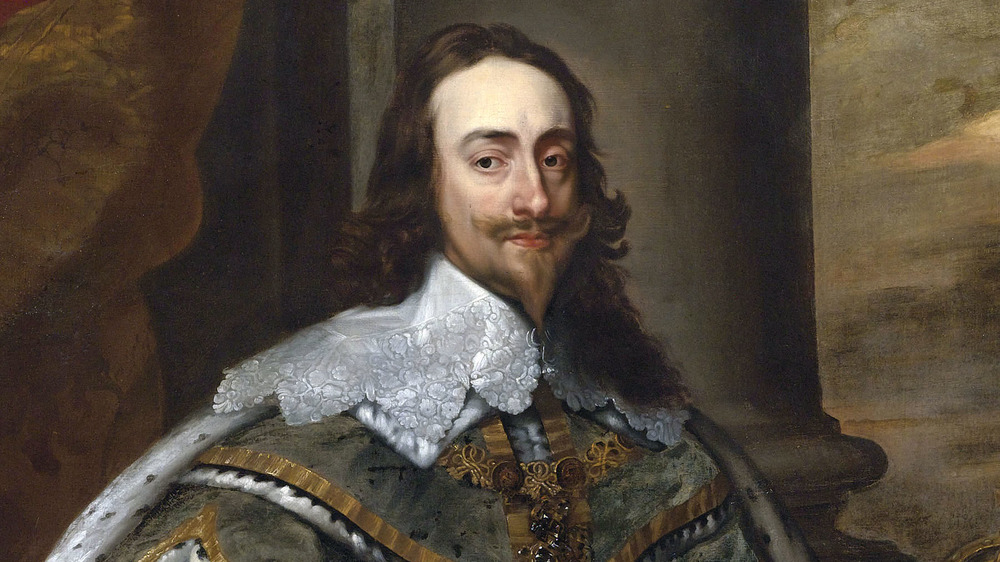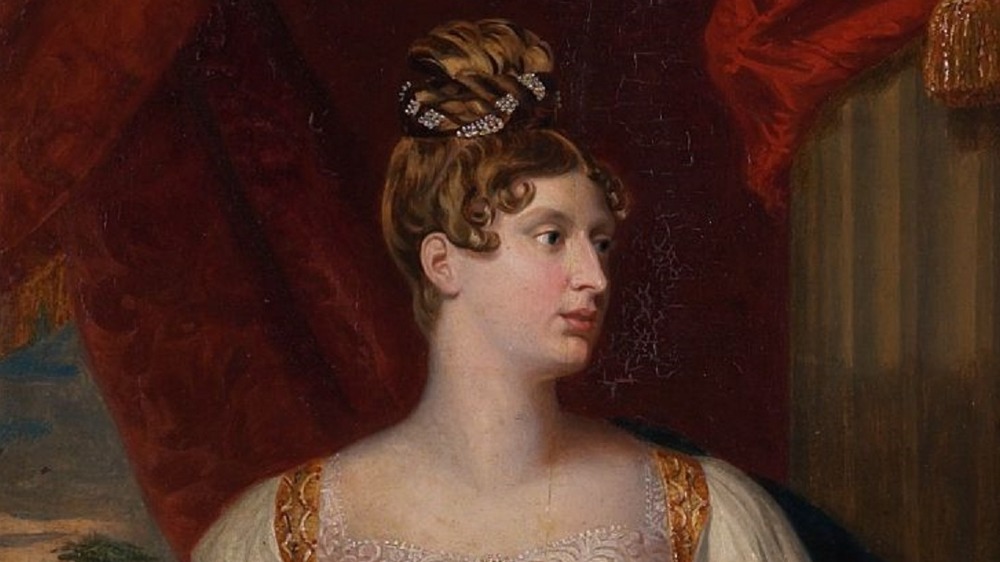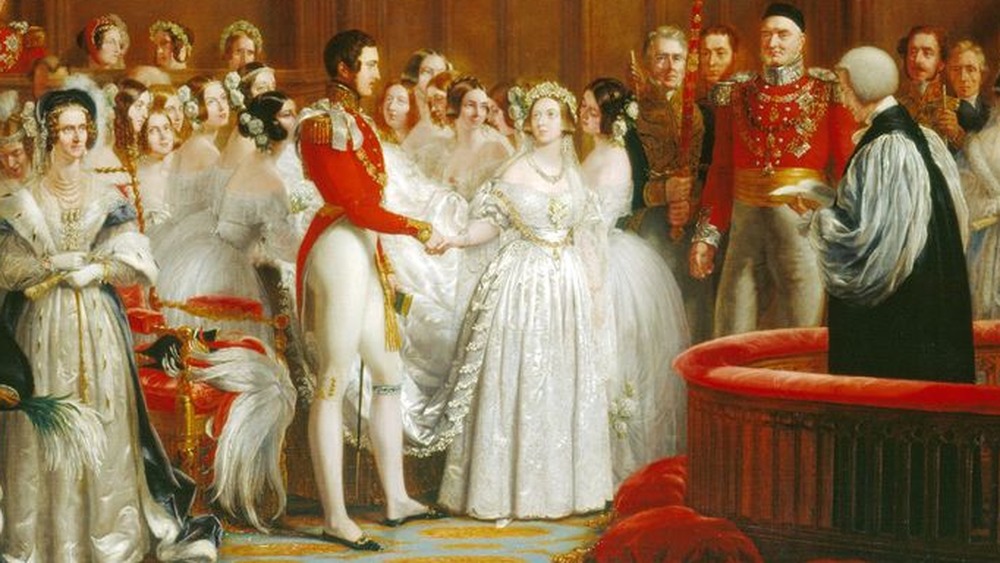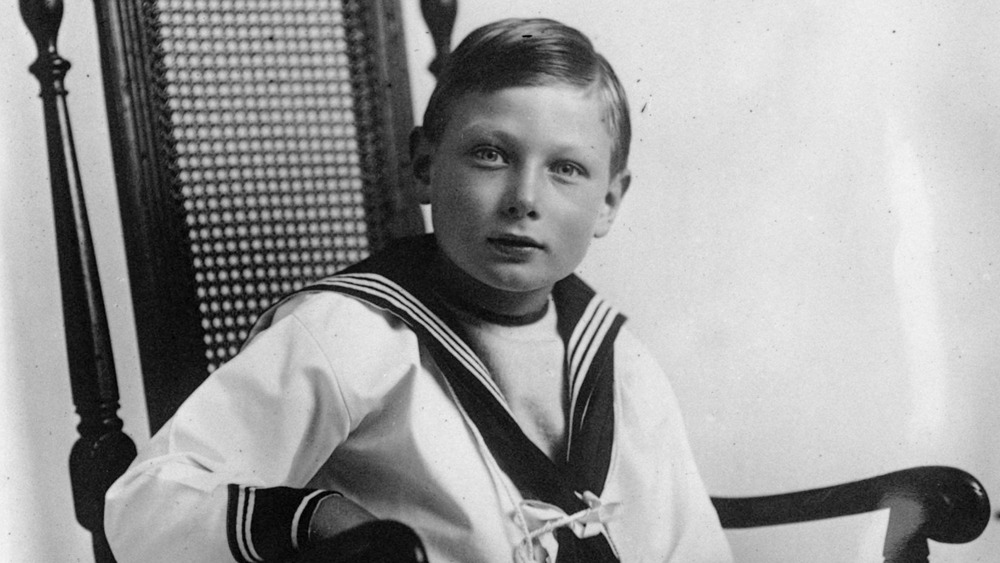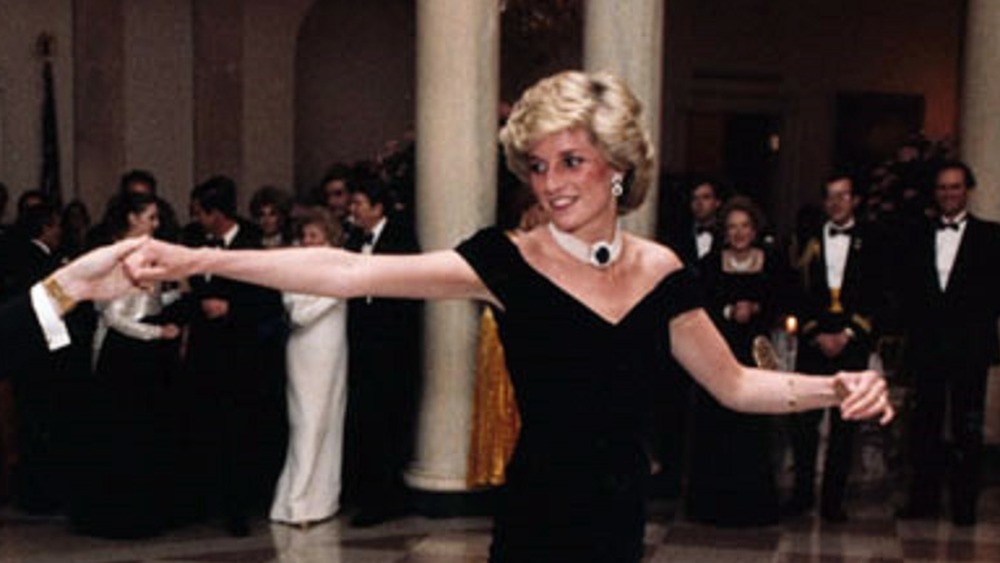The Most Tragic Deaths In The British Royal Family
"Uneasy lies the head that wears a crown," wrote Shakespeare in Henry IV, Part II, but you don't even have to be wearing the crown to be at risk of losing your head. Just being a little too close to inheriting it can be enough to get you killed prematurely.
Being part of the British royal family isn't all jewels, palaces, and waving from fancy cars, and it won't protect you from a fatal illness or a sharp sword or an arrow in the eye... While some kings have killed their way to the crown, others have paved the way for someone else by dying unexpectedly. Deaths in the British royal family affect the victim's relatives, send a wave of grief — and sometimes relief — through the nation, and occasionally change the course of history. Featuring betrayals, beheadings, and lots of people with the same names, these are the most tragic deaths in the British royal family.
King William II's sibling rivalry may have escalated to murder
The third son of William the Conqueror, King William II was his father's favorite. The older William skipped his two older sons to leave the English throne to his namesake, who was crowned upon his father's death in 1087. Meanwhile, Robert, William the Conqueror's oldest son, had to make do with inheriting the much less impressive title of Duke of Normandy, Normandy being the area on the northern coast of France that William the Conqueror had left to conquer England in 1066.
William II lived up to his father's nickname. According to the BBC, he fought off a rebellion that was trying to install Robert as king just a year after his coronation. He then defeated Robert in battle a year later, reducing his brother to an even more limited role. He also crushed a Scottish rebellion, killed their king, and kept their new kings loyal to him. And he had a habit of seizing church land.
However, William II may ultimately have been outdone by another brother. He was shot through the eye while hunting, possibly by accident, although rumor had it that his supposed killer, Walter Tirel, was carrying out orders from Henry, William II's younger brother, who became Henry I. William II's subjects didn't mourn him too long. His entourage immediately abandoned his body, which was transported to Winchester Cathedral by cart, still dripping blood.
The Princes in the Tower remain a tragic royal mystery
Fair warning: almost everyone in this story is called either Richard or Edward. Edward IV came to power in a bloody battle that ultimately saw him imprison the previous king, Henry VI, in the Tower of London. Not content, Edward IV and his brother Richard, Duke of Gloucester, later murdered Henry in the Tower, followed by their own brother, George, Duke of Clarence.
When Edward IV died suddenly in 1483, his 12-year-old son Edward was supposed to be crowned king, according to the BBC, with Uncle Richard, Duke of Gloucester, serving as protector. However, on the way to London for Edward's coronation, he and his 9-year-old brother Richard were more or less kidnapped by their uncle. They were taken to the very same Tower their father had so enjoyed using to imprison people he saw as threats to his power. Meanwhile, the Duke of Gloucester managed to have them declared illegitimate and was crowned Richard III. (Yes, of Shakespearean infamy.) The boys were never seen again.
It was long rumored that Richard III had the princes murdered. In 1674, bones of children were found under a staircase in the Tower of London, which were believed to belong to the two princes. They were moved to Westminster Abbey — where the oldest prince, Edward, had been born — and stored in a specially made marble urn, but the Church of England has so far refused to allow DNA testing.
The tragic death of Arthur, Prince of Wales, changed the course of history
Richard III's sneaky move to steal the crown led to divisions within his own House of York — the family that had taken control of the English throne from their great rivals the Lancasters when Edward IV defeated Henry VI. This allowed Henry Tudor — a Lancaster — to lead a rebellion against Richard III, who became the last English monarch to die in battle, according to the BBC. To end the Lancaster versus York standoff (aka the War of the Roses) the newly crowned Henry VII married Elizabeth of York, sister of the two princes in the Tower (and supposedly the model for the Queen of Hearts on playing cards.) They had four children, Arthur, Mary, Henry, and Margaret, between 1486 and 1496.
Arthur, the heir, was named after the legendary King Arthur, and raised from birth to be a king. When he was barely three, his father arranged for him to marry Catherine of Aragon, a Spanish princess, when they were both 15, securing a union between Spain and England. It was the first flashy royal wedding, complete with performances, tournaments, and feasts. But less than a year later, in April 1502, Arthur died of "sweating sickness," making Henry the heir.
Determined to keep his deal with Spain intact, Henry VII convinced everyone that the marriage had not been consummated. The widowed Catherine was engaged to her brother-in-law, who became Henry VIII when his father died in 1509.
Anne Boleyn won Henry VIII's hand and lost her head
Henry VIII and Catherine of Aragon married in 1509 and were relatively happy until around 1526. By then, they'd only had a daughter — the future Mary I — and Henry wanted a son. He'd also fallen in lust with a courtier, 20-something Anne Boleyn.
Henry offered to make Anne his mistress, but she refused: the daughter of a socially ambitious family, she wanted to be his queen. According to the Guardian, she refused to sleep with Henry until he got divorced, a process that ultimately led him to uproot England's entire religious system. By cutting ties with the Catholic Church and declaring himself head of the Protestant Church of England, Henry risked embargoes and war with Catholic Europe. For the moment he thought it was worth it, but his chief minister Thomas Cromwell, a former friend of Anne's, was concerned about the political risks their marriage created.
Anne gave birth to a daughter — the future Elizabeth I — but no son. By then Henry wanted to marry courtier Jane Seymour, so he and Cromwell conspired to create charges against Anne, including incest and adultery. Anne was executed, at Henry's command, in 1536, alongside her brother. The only mercy the king showed her was that he specified that she be beheaded by sword, considered less brutal than an ax or being, say, burned alive.
Catherine Howard's past was used against her
In July 1840, four years and two wives after Anne Boleyn's execution, Anne's first cousin, Catherine Howard, became Henry VIII's fifth wife. Like Anne, Catherine was a granddaughter of the Duke of Norfolk, but her branch of the family had fallen on tough times. Catherine caught the king's eye when she served as maid of honor to Henry's fourth wife, Anne of Cleves. Henry had that marriage annulled six months later, and married Catherine less than three weeks after that — the same day, according to the Telegraph, that he had Cromwell executed. Catherine's exact birthdate is unknown but is somewhere between 1518 and 1524, meaning she would have been between 16 and 22 when she married 49-year-old Henry.
Rumors soon spread that Catherine had engaged in sexual relationships with men before the king (possibly non-consensual ones), which would have invalidated their marriage. When Henry found out, two of the men were tortured. One confessed to a past affair, and one confessed to a current one, although whether that's true is in doubt.
Catherine was found guilty of treason and she and the men were sentenced to death. Her execution took place a few months after theirs. Like Anne, she was beheaded and buried at the Tower of London: she likely saw their rotting heads displayed on London Bridge as she was transported to her fate.
Edward VI and Lady Jane Grey were young monarchs treated as pawns
Henry VIII finally got his much-longed-for male heir in October 1537, when his third wife, Jane Seymour, gave birth to their son Edward. (Jane died less than two weeks later.) Edward became Edward VI in January 1547, aged nine, the BBC reports. He was easily controlled by his uncle and protector, Edward Seymour, Duke of Somerset, and later by John Dudley, Earl of Warwick, future Duke of Northumberland.
Both advisors and the young king were determined to force through Protestant reforms. So when Edward became ill with tuberculosis in 1553, Dudley persuaded him to change the line of succession to bypass his sister Mary, a Catholic, in favor of 15-year-old Lady Jane Grey. Jane was Dudley's daughter-in-law, the daughter of the Duke of Suffolk, and Henry VIII's great-niece through his sister Mary. Edward died on July 6, 1553, and Jane was crowned four days later. However, Mary had the public's support. Nine days after being crowned, Jane surrendered her throne.
Jane and her husband were imprisoned in the Tower of London, charged with treason, and sentenced to death in November 1553, but the newly crowned Queen Mary chose to spare them. Unfortunately, in February 1554, Jane's father tried another unsuccessful rebellion, which convinced Mary that she had to snuff out any potential threats. Jane watched as her husband was executed, then followed him to the block two hours later.
Henry Frederick should have been Henry IX
Elizabeth I succeeded her half-sister Mary I in 1558, and ruled until her death in 1603. She named James VI of Scotland as her successor, making him also James I of England and the first monarch to rule both nations.
James already had an heir, Henry, and two other children, Elizabeth and Charles. Henry's status brought both privilege and pressure. The BBC reports that James saw his son as a tool to continue the House of Stuart's grip on the throne. Days after Henry was born, he was taken from his mother and sent to live in Stirling Castle, where he was given intense lessons in appropriate kingly behavior, and instilled with a sense of responsibility for continuing the monarchy under the Protestant faith.
When Henry turned 16, he officially became Prince of Wales in a ceremony that cost the equivalent of £10m ($13.5m) today. He continued to do princely things like building massive art, coin, and book collections. In October 1812, while engaging in another princely thing — rugged outdoor sport, specifically swimming in the River Thames — Henry contracted what was probably typhoid fever and died, aged 18. The entire nation mourned the immensely popular prince. Crowds lined the funeral route, but Henry's parents were too grief-stricken to attend, leaving his 10-year-old brother Charles to take up the mantle as chief mourner and replacement heir.
Charles I was executed by his subjects
We can't know how Henry IX would have performed as king, but he couldn't have done a worse job than his brother, who was crowned Charles I in 1625. Charles believed that the monarch was answerable only to God. And speaking of God, the BBC reports that Charles' High Anglican religion looked too close to Catholicism for comfort to his mainly Protestant subjects. (It didn't help that his wife was Catholic.) Incapable of compromise, Charles kept dissolving Parliament rather than bend to its demands, forcing through taxes on his own. Finally, when he tried to raise another tax to fight the Scots and an army to fight the Irish, and to have multiple Members of Parliament arrested, Civil War broke out.
The war between the Cavaliers (Team Charles) and the Roundheads (Team Parliament) lasted between 1642 and 1646, when Charles surrendered. However, after he escaped from prison and started and lost another civil war, a group of radical Parliamentarians, led by Oliver Cromwell, tried him for treason and sentenced him to death.
Charles spent his last days at St. James' Palace in London with his two youngest children, whom he tried to comfort. On January 30, 1649, he donned a black cloak and walked through St. James' park to the Banqueting House at Whitehall, where he became the only British monarch to be executed for treason (so far...)
The death of Princess Charlotte Augusta of Wales devastated the public
After 11 monarchy-free years, Parliament invited Charles' son to become Charles II in 1660. Succession was a muddle for the next five decades, but in 1714, James I's great-grandson became the first of many King Georges to take the English throne. According to the BBC, George IV became king in 1820 but started ruling as regent in 1811, when his father George III's mental health issues prevented him from acting as king. The Prince Regent was reckless and extravagant. His most popular contribution to the country was his daughter, Princess Charlotte Augusta of Wales, born in 1796.
Like her parents, Charlotte had a scandalous love life. She had affairs with an Army captain and a couple of lowly princes, among others. In 1814, she was forced into an engagement with William, Hereditary Prince of Orange, but a year later she broke centuries of royal protocol by calling it off.
Instead, Charlotte persuaded her father to let her marry Prince Leopold of Saxe-Coburg, in 1816. The couple was very popular with the public, and became even more so when it was announced in early 1817 that Charlotte was pregnant. But sadly, that November, the princess died, aged 21, five hours after giving birth to a stillborn child. Her parents, husband, and the nation went into deep mourning. The funds for the marker on her tomb were raised by the public in tribute to their would-be queen.
Queen Victoria blamed her heir for Prince Albert's death
In 1830, now-heirless George IV's throne passed to his brother, who became William IV. William had 10 children but no legitimate heirs, so the throne went to his 18-year-old niece, Victoria, in 1837. Victoria was pressured to marry but she was against the idea — until October 1839, when she fell mutually in love with her first cousin, Prince Albert of Saxe-Coburg and Gotha. Victoria, who outranked Albert, proposed five days later. He said yes.
On February 10, 1840, Albert and Victoria married in a huge ceremony that set the fashion for lavish royal weddings — and for white wedding dresses. Victoria wrote of her wedding, "This was the happiest day of my life!" according to Vanity Fair. Her relationship with Albert remained passionate — they had nine children, even though she hated being pregnant — but also argumentative when their strong personalities clashed.
In 1861, Albert, who had been in poor health, visited their wayward oldest son and heir, Albert Edward (known as Bertie), to admonish him for a scandalous relationship. During the trip, Albert caught typhoid fever: he died three weeks later. Queen Victoria was devastated. She wore mourning black for the rest of her life — which lasted 40 more years — and became reclusive. A notoriously cold mother, she blamed Bertie, writing, "I never can or shall look at him without a shudder."
Prince John was shunned by his family
Bertie became Edward VII in 1901, passing the throne to his son, George V, in 1910. George and his wife Mary of Teck had six children, whom the king ruled over as a military-like figure while the queen showed little interest. George was highly critical and impatient. He forced another George, their second-oldest son, to wear painful leg braces to "correct" his knock-knees, and shouted at him about his speech impediment.
However, Prince John, the couple's youngest child, arguably suffered most. Known today as the Lost Prince, John was epileptic and possibly also autistic. According to the LA Times, he couldn't spell, draw a straight line, or complete simple intelligence tests. He was sweet-natured, and tended to take things literally.
John's parents decided that he was unfit to be associated with the royals, and sent him to live in a cottage on the Sandringham Estate (where the royal family's Christmas takes place) in the care of a loving nurse. John wrote affectionate letters to his family, but rarely saw them. In 1919, aged 13, he died of a severe seizure. According to the Telegraph, John's oldest brother, the future Edward VIII — the Nazi supporter who abdicated the throne in 1936 — wrote that "the animal" had died, and resented having to pretend to mourn him.
The sudden death of Princess Diana brought the nation to a standstill
George VI succeeded his brother when the latter abdicated in 1936, passing the throne to his daughter, Elizabeth II, upon his death in 1956. Elizabeth II married Philip, then-prince of Greece and Denmark and now the Duke of Edinburgh, in 1947, and in 1948 their oldest son Charles was born.
Charles' great love was Camilla Shand, whom he met in 1971. But according to TIME, the royal family considered her an unsuitable match, since she didn't have a title and was reportedly not a virgin. Instead, in July 1981, 32-year-old Charles married Diana Spencer, 19-year-old daughter of the Earl of Spencer, who became the Princess of Wales. Unpretentious and warm, Diana was extremely popular with the public, with made Charles jealous. The marriage was troubled from the start, and the couple's divorce was finalized in 1996, at which point Diana was ejected from the royal family.
One year and three days later, Diana was killed in a car crash in Paris. The nation went into mourning, laying a sea of flowers outside the gates of Buckingham Palace. The Queen was criticized for her seemingly cold response. Under public pressure, she decided to allow Diana a royal funeral. She also conceded to having a Union Flag flown at half-mast at Buckingham Palace, which had only ever flown the Royal Standard to indicate the Queen's presence.
